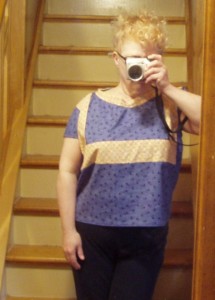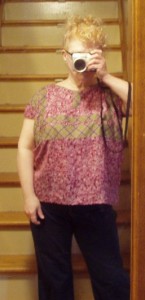 Now, usually, your Aunt Toby is one to say, “In sewing, fit is everything,” but in a case where there is no ‘fit’ per se, fabric is everything. OK, in these two cases, it is not only fabric that determines the look, but also one other thing: One inch. Literally one inch in the width measurement makes a huge difference in the look. I did not think it would make that much of a difference, but it did.
Now, usually, your Aunt Toby is one to say, “In sewing, fit is everything,” but in a case where there is no ‘fit’ per se, fabric is everything. OK, in these two cases, it is not only fabric that determines the look, but also one other thing: One inch. Literally one inch in the width measurement makes a huge difference in the look. I did not think it would make that much of a difference, but it did.
First up – the top above, made of quilting cotton. The fabric was washed before I made it and I followed my formula from the last post – biggest measurement, divided by 2, plus 5″. This is also actually a couple of inches shorter, but no bother. I actually like the look better in this incarnation than in the next one, but I’m good with both, actually. Again, this top and this style top is going to have some action in my wardrobe this summer. Certainly the easiest thing to sew, EVER. No buttons, no zips. Each one of these (minus the time for washing, drying and ironing the fabrics and cutting the contrasting strips out) took a couple of hours and most of that was placing, pinning and sewing on the contrasting strips. Perfect ‘fiddle around in the evening’ project.
 Second up. This on literally is one inch bigger on the width measurement and a little longer. It is also made of cotton voile. Boy, what a difference that fabric makes, doesn’t it? On the other hand, it’s literally ‘light as a feather’ and will be great for wearing when it gets hot and sticky later. But I think I will take it in a bit at the sides for a little bit less ‘blousy’ look on me.
Second up. This on literally is one inch bigger on the width measurement and a little longer. It is also made of cotton voile. Boy, what a difference that fabric makes, doesn’t it? On the other hand, it’s literally ‘light as a feather’ and will be great for wearing when it gets hot and sticky later. But I think I will take it in a bit at the sides for a little bit less ‘blousy’ look on me.
A couple of thoughts:
In doing a bit more research on Frida Kahlo and her huipils, I found out that most of the decoration on these is actually very dense embroidery, which means that these were a real ‘economic development’ project for her – she bought the fabrics themselves but paid indigenous artisans to make them for her. These were not items which she just picked up in a shop or off a stall in Mexico City. I’m also fairly sure (though again, I’ve never seen one of these in person and so have not held one in my hands) that these weigh a good bit; all of that dense embroidery would require a fairly solid fabric to support it and between that and the embroidery itself, these were not lightweight tops.
Another thought is this: Am I, by using this concept and basic design, indulging in what is referred to today as, ‘cultural appropriation’? That’s a good question and one I continue to go over in my head as I go through these exercises on traditional clothing. I’m not trying to pass off what I’m doing here as a real huipil from the Tehuana region in Mexico; no one looking at them can be in any doubt of that. I feel also a tremendous amount of respect and honor for the artisans who produced the garments for Frida Kahlo to wear and who continue to produce them today. These garments, from skills and time they take in the weaving, embroidery and sewing, are worth every penny of the hundreds of dollars that are being asked for them (though I sometimes wonder if the artisans themselves are being paid that much for all their time and skill). But, from the viewpoint of ‘if I want to make a garment which is simple and sparing of fabric and resources’ standpoint, I think the huipil is an excellent basic traditional garment to use as a model.

